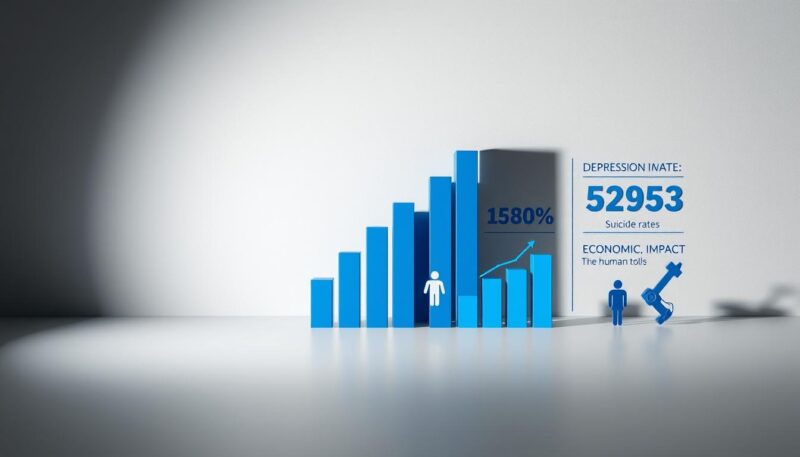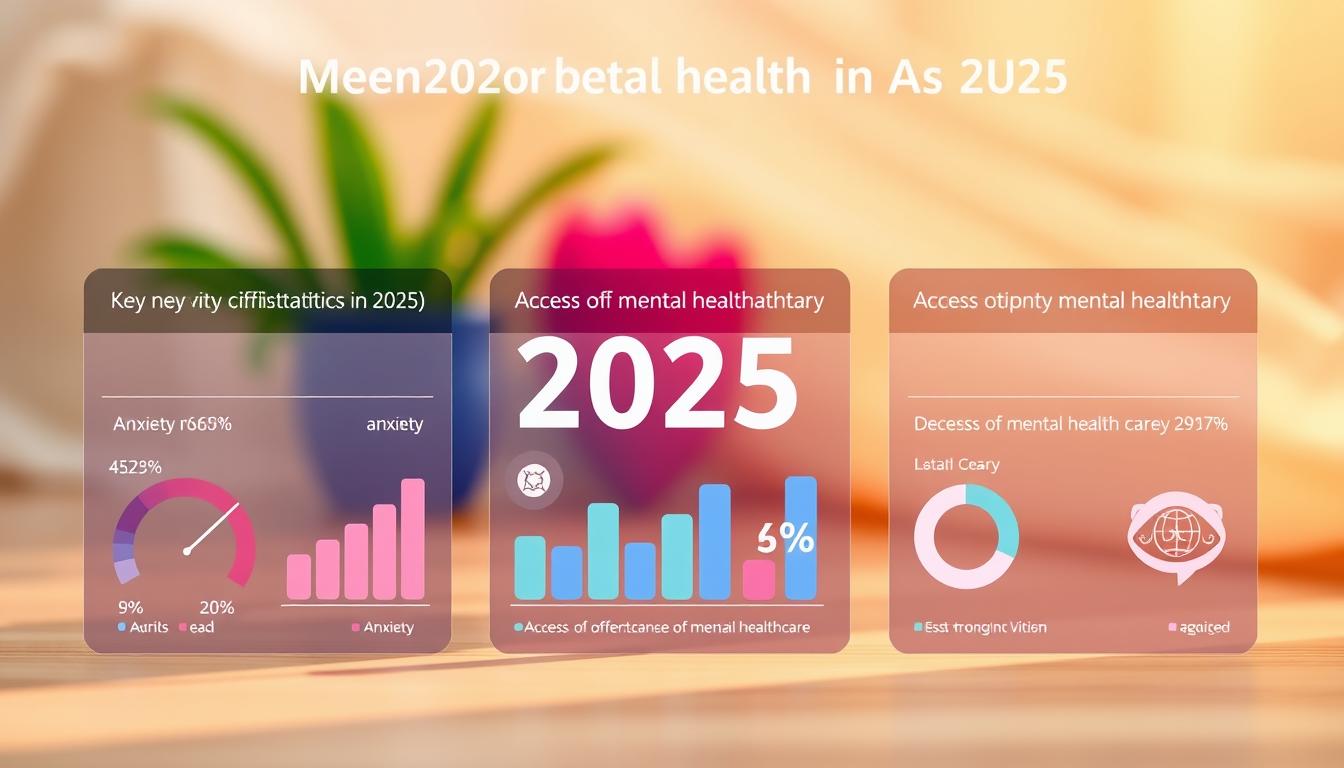Recent data indicates a significant prevalence of mental illness among U.S. adults, with 22.8% experiencing mental illness in 2021, representing 57.8 million people or 1 in 5 adults.
This comprehensive report examines the latest mental health statistics in the United States for 2025, providing an evidence-based overview of the current landscape of mental health conditions across the nation.
The prevalence rates of common mental health disorders, including anxiety and depression, will be analyzed, highlighting demographic patterns and shifts since previous years.
Key Takeaways
- Prevalence of mental illness among U.S. adults in 2021 was 22.8%.
- 1 in 5 adults experienced mental illness in 2021.
- Serious mental illness affected 5.5% of U.S. adults in 2021.
- The report will analyze demographic patterns and shifts in mental health disorders.
- Detailed information on mental health treatment accessibility will be presented.
Current State of Mental Health in America
The mental health landscape in America is undergoing significant changes as of 2025. Understanding these shifts is crucial for addressing the mental health needs of the population.
Prevalence of Mental Illness in 2025
In 2022, an estimated 59.3 million adults aged 18 or older in the United States had Any Mental Illness (AMI), representing 23.1% of all U.S. adults. The prevalence of AMI was higher among females (26.4%) than males (19.7%). Young adults aged 18-25 years had the highest prevalence of AMI at 36.2%, compared to 29.4% among adults aged 26-49 years and 13.9% among those aged 50 and older.
| Age Group | Prevalence of AMI |
|---|---|
| 18-25 years | 36.2% |
| 26-49 years | 29.4% |
| 50 and older | 13.9% |
Key Trends Since 2022
Since 2022, there have been significant shifts in mental illness rates among U.S. adults. The data highlights an increase in mental health issues, particularly among young adults and females. The post-pandemic era has seen emerging mental health trends, with COVID-19 having a lasting impact on the nation’s mental wellbeing.
The trends indicate a need for targeted interventions and support services to address the growing mental health concerns among U.S. adults.
Mental Health Statistics in US: Adult Population Data
Understanding mental health statistics among US adults is crucial for addressing the issue effectively. Mental illness among adults is a significant public health concern, affecting various aspects of their lives.
According to recent data, a substantial number of U.S. adults experience mental health issues, with varying prevalence rates across different demographic groups. As stated by mental health experts, “Mental health is just as important as physical health, and it’s essential to address the issue with the same level of care and attention.” Recent studies have highlighted the need for comprehensive data to understand the scope of the problem.
Any Mental Illness (AMI) Prevalence
Any Mental Illness (AMI) encompasses a broad range of mental health conditions. In 2022, the prevalence of AMI among U.S. adults was significant, with certain demographic groups showing higher rates than others. For instance, young adults and females were found to have higher rates of AMI.
The data indicates that AMI prevalence varies across different age groups, with younger adults being more affected. Socioeconomic factors also play a crucial role in determining the prevalence of AMI among U.S. adults.

Serious Mental Illness (SMI) Rates
Serious Mental Illness (SMI) represents more severe mental health conditions that substantially interfere with major life activities. In 2022, an estimated 15.4 million adults aged 18 or older in the United States had SMI, representing 6.0% of all U.S. adults.
The observed prevalence of SMI was higher among females (7.1%) than males (4.8%). Young adults aged 18-25 years had the highest prevalence of SMI (11.6%) compared to other age groups. These statistics underscore the need for targeted interventions to address SMI among vulnerable populations.
As the data suggests, mental health issues among U.S. adults are a significant concern, requiring a comprehensive approach to address the problem effectively.
Anxiety Disorders: A Growing Concern
Anxiety disorders represent a growing public health issue, impacting millions of Americans. As of 2025, these conditions are increasingly prevalent, affecting various demographic groups across the United States. Anxiety disorders encompass a range of conditions, including generalized anxiety disorder, social anxiety, and panic disorder, among others.
Prevalence by Demographic Groups
Anxiety disorders affect different populations at varying rates. According to national data, 19.1% of U.S. adults experience anxiety disorders annually. In children aged 3-17, 11% had diagnosed anxiety between 2022-2023, with higher rates among females (12%) compared to males (9%). Among adolescents aged 12-17, 20% reported anxiety symptoms in the past two weeks.
The prevalence of anxiety disorders varies by demographic factors such as age, gender, race/ethnicity, and geographic location. Understanding these differences is crucial for targeted interventions and support.
Impact of Anxiety on Daily Functioning
Anxiety symptoms significantly impact daily functioning, affecting work productivity, relationships, physical health, and overall quality of life. Individuals with anxiety disorders often experience co-occurring mental health conditions, complicating treatment and management.
The impact of anxiety on daily life can be profound, leading to decreased productivity and strained personal relationships. Effective management of anxiety disorders is essential to mitigate these effects and improve mental health outcomes.
Depression Statistics and Trends
Understanding depression statistics is crucial for addressing the mental health needs of the American population. Depression is a significant mental health condition that affects individuals across various demographics.

Major Depressive Disorder Prevalence
Major Depressive Episode affects 8.3% of U.S. adults annually, indicating a significant prevalence of major depressive disorder. This condition is characterized by persistent feelings of sadness or hopelessness, often accompanied by changes in appetite, sleep disturbances, and fatigue. In 2022-2023, it was reported that 4% of children aged 3-17 had current, diagnosed depression, with higher rates among females (6%) than males (3%).
- Among US adolescents ages 12-17 in 2021-2023, 18% reported symptoms of depression in the past two weeks.
- Among US high school students in 2023, 40% reported persistent feelings of sadness or hopelessness in the past year.
Depression Among Different Age Groups
Depression affects various age groups differently. Among children and adolescents, depression can manifest as irritability or behavioral problems, while in adults, it often presents as persistent sadness or loss of interest in activities. The prevalence of depression among different age groups highlights the need for age-specific interventions.
“Depression is a serious mental health condition that requires comprehensive treatment and support. Understanding its prevalence across different age groups is crucial for developing effective mental health strategies.”
By examining depression statistics and trends, we can better understand the scope of this mental health condition and work towards improving care access and outcomes for those affected.
Youth Mental Health Crisis
America’s young population is grappling with a severe mental health crisis. The prevalence of mental health issues among children and adolescents has been on the rise, affecting their well-being and academic performance.
Mental Health Conditions in Children and Adolescents
Nearly 1 in 5 children aged 3 to 17 (21%) had been diagnosed with a mental, emotional, or behavioral health condition as of 2021. The statistics are equally concerning for high school students, with 40% reporting persistent feelings of sadness or hopelessness in 2023. Anxiety and depression are among the most common mental health disorders affecting youth.
The data indicates a significant increase in mental health challenges among young people, highlighting the need for effective support systems.
School Impact and Educational Outcomes
Students aged 6-17 with mental, emotional, or behavioral concerns are three times more likely to repeat a grade. The impact of mental health issues on academic performance is substantial, with affected students facing challenges in attendance and overall educational outcomes.
The relationship between youth mental health and substance use is also a concern, with increased rates of alcohol, marijuana, and other drug use among adolescents with mental health conditions.
School-based mental health services play a crucial role in addressing the youth mental health crisis. Identifying effective interventions and highlighting gaps in current support systems are essential steps toward improving mental health outcomes for young people.
Mental Health Treatment and Care Access
Access to mental health treatment remains a critical issue in the United States, with significant disparities across different demographic groups. In 2022, among the 59.3 million adults with Any Mental Illness (AMI), 30.0 million (50.6%) received mental health treatment in the past year. This statistic highlights the ongoing challenge of ensuring that individuals with mental health needs receive appropriate care.
Treatment Rates Across Demographics
Treatment rates for mental health conditions vary significantly across different demographics. More females with AMI (56.9%) received mental health treatment than males with AMI (41.6%). Similarly, among the 15.4 million adults with Serious Mental Illness (SMI), 10.2 million (66.7%) received mental health treatment in the past year. These figures indicate a gender disparity in mental health care access, with women being more likely to receive treatment than men.
The utilization of mental health services also varies by age, race/ethnicity, and socioeconomic status. Understanding these differences is crucial for developing targeted interventions to improve mental health care access for underserved populations.

Barriers to Mental Health Care
Despite the progress made in mental health treatment, numerous barriers remain. According to recent data, 160 million people live in a designated Mental Health Professional Shortage Area, highlighting the issue of provider shortages. Other significant barriers include insurance coverage issues, cost concerns, stigma associated with mental illness, and geographic limitations.
Addressing these barriers is essential to improving mental health care access. For instance, expanding telehealth options can help bridge the gap in areas with provider shortages. Additionally, reducing stigma through public awareness campaigns and improving insurance coverage for mental health services can encourage more individuals to seek care. For more information on mental health services, visit this resource.
The Economic and Social Impact of Mental Illness
Mental illness imposes significant economic and social burdens on the United States. The far-reaching consequences of mental health conditions affect not only individuals but also the broader economy and society as a whole.
Healthcare Costs and Economic Burden
The economic impact of mental illness is substantial, with serious mental illness causing $193.2 billion in lost earnings annually across the U.S. economy. Depression and anxiety disorders alone cost the global economy $1 trillion in lost productivity each year. The healthcare expenditures related to mental health conditions are significant, including costs associated with hospitalization, outpatient care, medication, and emergency services.
| Economic Impact | Cost |
|---|---|
| Lost Earnings due to Serious Mental Illness | $193.2 billion |
| Global Cost of Depression and Anxiety Disorders | $1 trillion |
Social Consequences and Quality of Life
Mental illness also has profound social consequences, affecting quality of life measures such as relationships, housing stability, community engagement, and overall life satisfaction. The prevalence of co-occurring substance use disorders among individuals with mental illness further complicates these issues. In 2021, 7.6% of U.S. adults experienced both a substance use disorder and mental illness, totaling 19.4 million people.
The interplay between mental illness and substance use disorders highlights the need for comprehensive care approaches that address both conditions simultaneously.

Conclusion: Future Directions for Mental Health Care in America
As we navigate the complexities of mental health in 2025, it’s clear that the COVID-19 pandemic has left an indelible mark on the nation’s mental wellbeing. The statistics presented in this article underscore the pressing challenges facing America’s mental health care system, including the ongoing impacts of the pandemic on mental health.
Key findings indicate that 1 in 5 U.S. adults reported a significant negative impact on their mental health due to the pandemic, with 45% of those with mental illness and 55% of those with serious mental illness reporting significant negative impacts. The average delay between onset of mental illness symptoms and treatment is 11 years, highlighting the need for improved access to care.
Emerging trends in mental health care delivery, such as the expansion of telehealth services and integration of mental health into primary care, offer promising solutions. Policy initiatives aimed at expanding the mental health workforce and improving insurance coverage are crucial to addressing gaps in the mental health care system.
As we look to the future, continued data collection, research, and evidence-based interventions will be essential in addressing the nation’s mental health challenges. By prioritizing mental health care and implementing effective solutions, we can work towards a more comprehensive and supportive mental health care system in the United States.
FAQ
What is the prevalence of major depressive disorder among U.S. adults?
According to recent data, major depressive disorder affects a significant portion of the adult population, with varying prevalence rates across different demographic groups.
How does anxiety impact daily functioning?
Anxiety can significantly impair daily functioning, affecting an individual’s ability to perform tasks, maintain relationships, and engage in daily activities.
What are the most common barriers to accessing mental health care?
Common barriers to mental health care include lack of insurance, high costs, social stigma, and limited access to mental health services, particularly in rural or underserved areas.
How has the COVID-19 pandemic affected mental health in the U.S.?
The COVID-19 pandemic has led to increased rates of anxiety, depression, and other mental health conditions, with certain populations, such as young people, being disproportionately affected.
What is the economic burden of mental illness in the United States?
Mental illness imposes a significant economic burden on the U.S. healthcare system, with estimated annual costs running into hundreds of billions of dollars.
How does mental health affect educational outcomes among youth?
Mental health conditions, such as anxiety and depression, can significantly impact educational outcomes, including academic performance and dropout rates, among children and adolescents.
What are the treatment rates for serious mental illness among U.S. adults?
Treatment rates for serious mental illness vary across different demographic groups, with some populations facing significant barriers to accessing effective care.
How does substance use disorder relate to mental health conditions?
Substance use disorder often co-occurs with mental health conditions, such as depression and anxiety, and can complicate treatment and recovery efforts.
